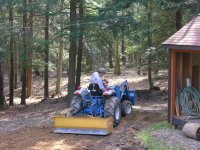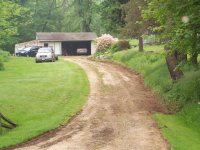I use a 60" KK behind a CK20. I have been know to actually overflow spoils from the box blade. I have found the trick to get it to work is to be smart as to what you are doing.
If I have the rippers clear down and the box tipped forward, don't add extra resistance by trying to move material at the same time. And just the opposite if you are trying to move a lot of material, keep the rippers out of the ground.
When working in rocky or root bound soil, loosen the soil first, taking it easy, as a single rock or root can bring you to a stop. When working in these conditions you do not need to lower all of the rippers. I lower the ones that make the most sense for what I am trying to accomplish. (left, center, or right) Once the ground is loosened, then I move the soil.
When using the bb to move material out of a location I usually distribute the spoils to a collection area. When it gets hard to transverse over the spoils I then move them to the final destination.
I have found that TNT can really have a postive effect in making this even easier. I set the rippers to a point where they don't dig when moving dirt, but a quick adjustment of the top link will let me angle the BB to where the rippers will dig but not accumulate spoils. (the same thing can be done with the manual top link but it is a lot slower.)
If I were doing this again, I would get the 60". Unless I found a really good deal on a 54", and would never buy a 48" since it would not cover my tire tracks.
Just as a side note - I do not have loaded tires or any extra weight added to the tractor (besides the loader), and I for working with dirt, rocks, and clay I have not had an issue with the KK weight. I could see where a weight could be a problem if working a dry compacted soil, I just have not ran into that problem yet.
Attached is a picture of a ditch that I put in over Memorial Day weekend. It primarily consisted of rocks and roots, slow and easy, not a problem (unless you count the one root that I left in place).

